Bergamo, a marvelous city with a very ancient history, divided into two parts(Bergamo Alta and Bergamo Bassa) equally fascinating and rich in monuments, set in one of the most active productive areas in all of Italy, an important center during Roman times, in the Middle Ages, and then from 1427 after its conquest by the Republic of Venice, to which it would be linked for centuries. Also known as “the city of the Thousand” because 180 volunteers following Giuseppe Garibaldi came from Bergamo itself, it is one of the 27 Italian cities decorated with the gold medal as “benemerite del Risorgimento nazionale,” just like neighboring Brescia. Bergamo still retains intact traces of its past, including the medieval alleys of Bergamo Alta, its Renaissance palaces, and the elegant 18th-19th century district of the lower city. There are many reasons to visit Bergamo: a starting point for hiking in the mountains, an active and bustling city, a city filled with cultural attractions (in 2023 it was awarded the title of Italian Capital of Culture along with Brescia), it never leaves those who visit it indifferent. Below is an itinerary of 10 places not to be missed during a visit to Bergamo.
The Mura Veneziane (Venetian Walls) of Bergamo Alta are imposing masonry works with ramparts built starting in 1561 by the Republic of Venice to stem any enemy attacks, when Bergamo was under the rule of the Serenissima. To build them, 250 buildings were demolished, 8 of which were religious. They are clearly visible and in an excellent state of maintenance having suffered no siege or experienced any wartime event, and they run for about 6 km along the hill of the upper city showing themselves mammoth but elegant at the same time, with some sections where they reach 50 meters in height. The circle of walls was designed with 4 monumental gates (the most scenic St. James Gate to the south, Porta San Lorenzo to the north, Porta Sant’Agostino and Porta Sant’Alessandro the other two of which the latter is named after the city’s patron saint) 14 bastions, 2 storeys, 32 sentry boxes, 100 openings for gun ports, two powder magazines... certain is that if someone had attacked the Bergamasks, they would have had to defend themselves! Today, having laid down its weapons, it is a fine place from which to admire the valley, pause and stroll along the gardens and tree-lined avenues that have replaced the rounds. A mighty defensive wall that has been part of the Unesco heritage since 2017. For those who cannot make it all the way up from the ’lower’ city on foot, it is possible to use a funicular railway at the top of which is an Art Nouveau café overlooking the panorama. They are undoubtedly the symbol of Bergamo.
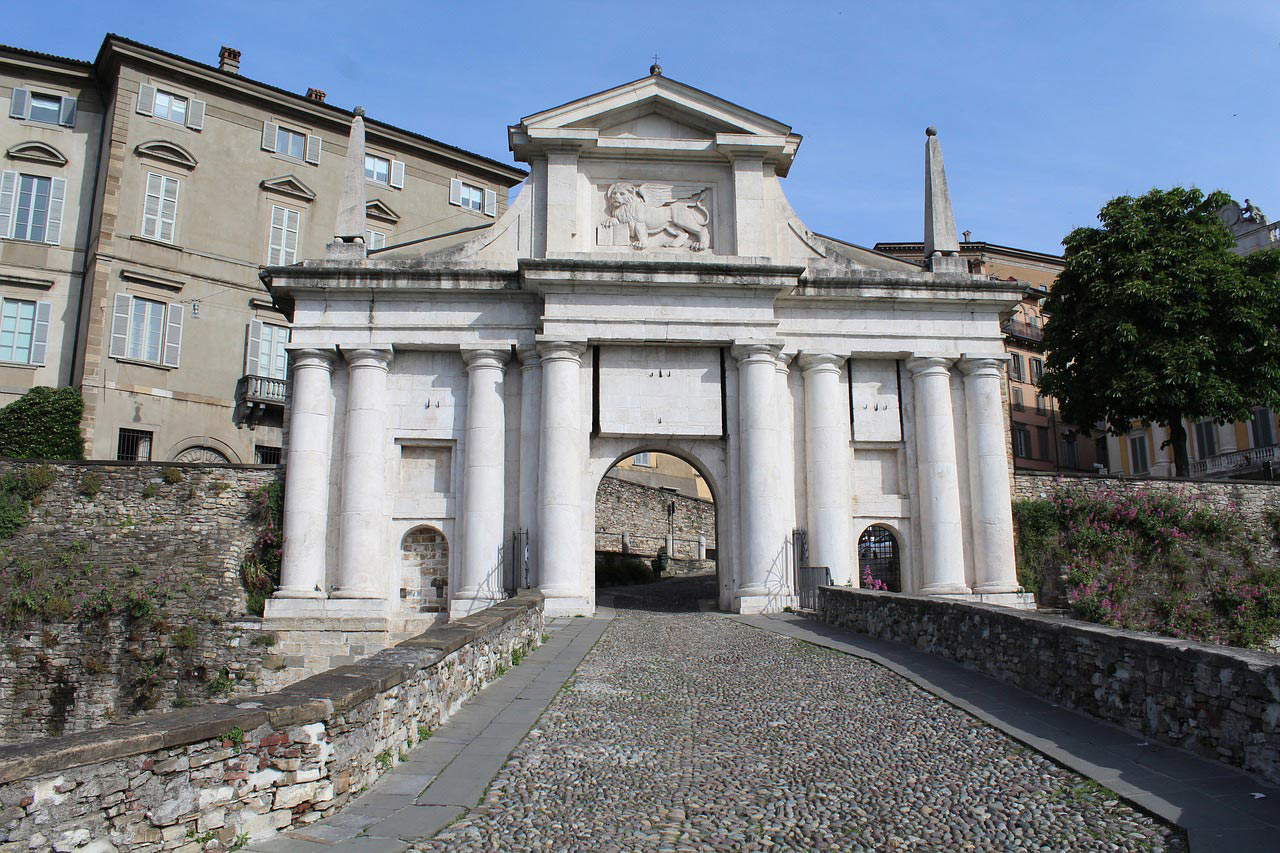
Located in Piazza Duomo, close to the basilica of Santa Maria Maggiore, the Colleoni Chapel is striking at first glance for its majesty and grandeur. The Chapel is the mausoleum that leader Bartolomeo Colleoni wanted for himself, entrusting the project to Renaissance architect and sculptor Giovanni Antonio Amadeo. The building is an architectural jewel and a treasure chest filled with works of art and Amadeo’s masterpiece. The façade is a valuable example of the Renaissance with bold and innovative solutions that are sure to be successful: the façade is framed by giant pilasters of Ionic order, which end in two pinnacles on either side of the crowning loggia to form a sequence of marble three-mullioned windows. The visual impact is given by the decorations in polychrome marble with red and black white lozenges, and one cannot fail to mention the large Gothic rose window, above the portal, with on either side depictions of Caesar and Trajan set in two medallions within a frame where pink predominates. The happy interweaving of chromatic and artistic solutions, busts, inlays, decorations, bas-reliefs, statues, makes it one of the city’s major attractions. Inside, on a square plan, in addition to the Sarcophagus of the condottiere and his little daughter who died when she was 14, we also find his effigy on a plastic equestrian statue as proof of the value with which he wanted to be remembered.
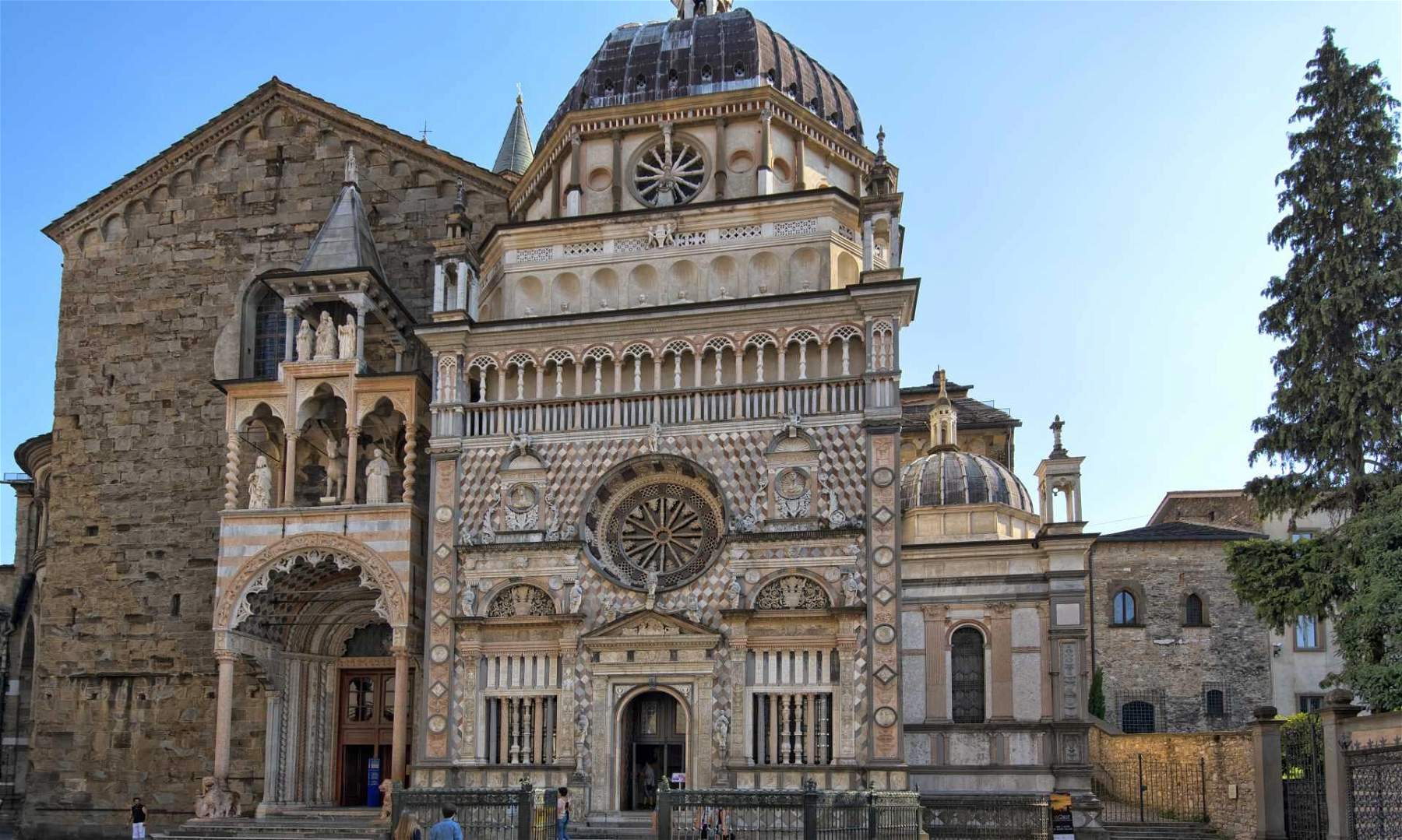
The Basilica of Santa Maria Maggiore, stands out in Piazza Duomo for its elegance, majesty and grandeur, despite not being the Duomo. It was built to give thanks to Our Lady in 1137 for safeguarding the people of Bergamo from a terrible pestilential period. All of Bergamo is imbued with this religiosity that finds its outlet and plastic gratitude in art. Church life and civic life are one and the same, so much so that between the two portals on the northern side are embedded in the wall the ancient parameters of measurement in force in Bergamo during the medieval period: the Capitium Comunis Pergami (cavezzo - 2.63 meters) and the Brachium (arm - 53.1 cm) to which weavers and merchants referred when doing business. The basilica has its peculiarity in having as a bulky and precious neighbor the Colleoni Chapel, which on that side takes the whole “scene.” There is no central entrance and the four entrances are side entrances, and four red (north) and white (south) marble lions by Giovanni da Campione (14th century) guard those entering on the north and south entrances. The interior, where there is also a memorial to the composer Gaetano Donizetti, is rendered of great beauty by the hand of Lorenzo Lotto, author of the splendid wooden inlays in the choir. The Romanesque women’s gallery houses the museum of the Treasure of Santa Maria Maggiore with precious sacred works, which opens twice a week at the hands of volunteers from the Italian Touring Club.
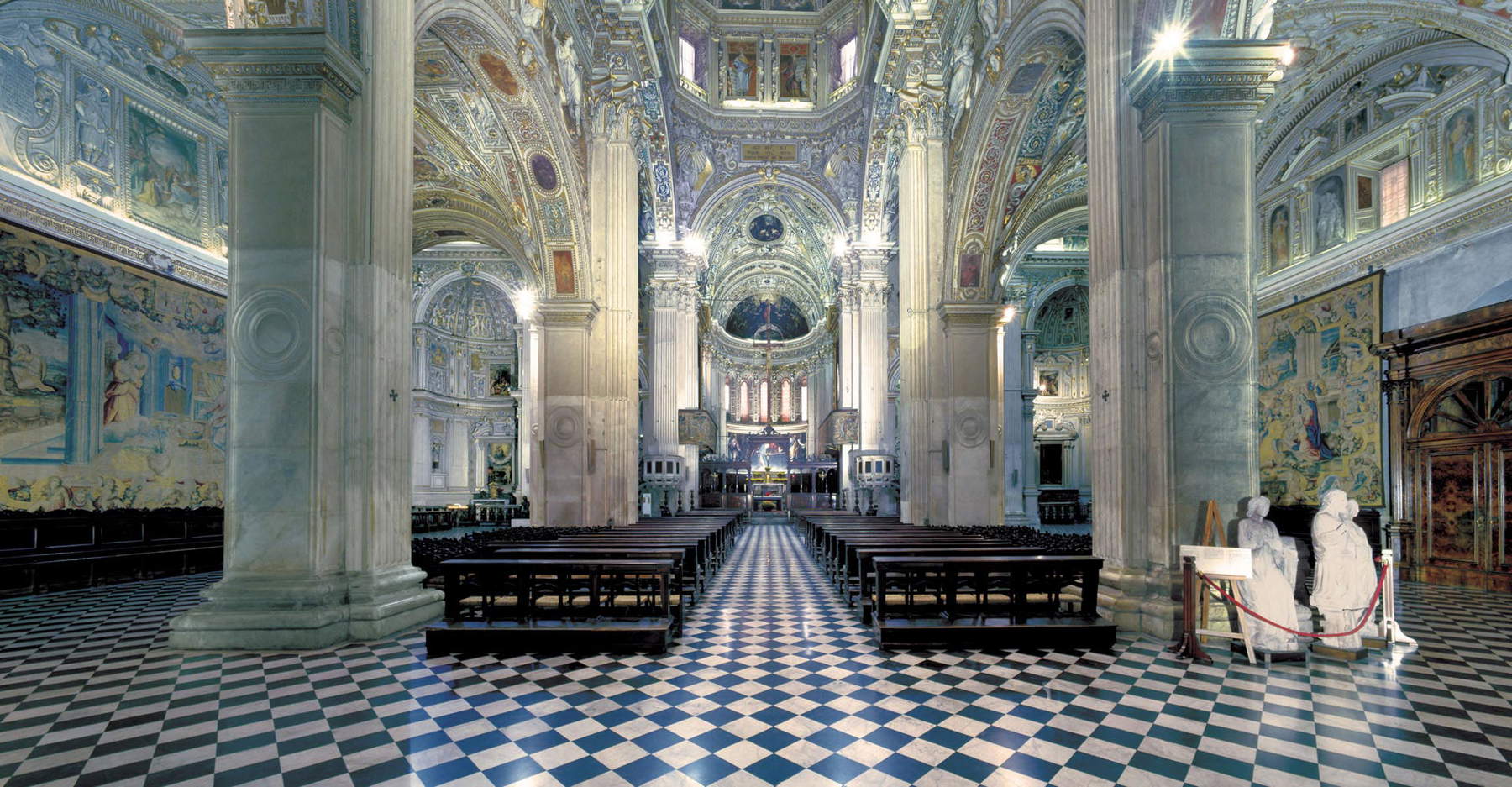
To the enlightened mind of Count Giacomo Carrara, Bergamo owes its largest picture gallery (which is also much more) and that school that was to become the Academy of Fine Arts with the aim of eruditing and intriguing young people, bringing them closer to beauty through those paintings and thus being able to embark on a new artistic path. This is theCarrara Academy, or simply “la Carrara,” based in the square of the same name, in a majestic neoclassical building. Founded in 1796, thanks to considerable bequests over time, the numbers of this among Italy’s leading picture galleries are impressive: 1,800 works including paintings, drawings, prints and sculptures (but also fans, porcelain, medals....) spanning five centuries of Italian art history. Mantegna’s Madonna and Child has its home here as do other canvases by Pisanello, Botticelli, Bellini, Moroni, Raphael, Tiepolo, and Canaletto. It is considered the Museum of Collections par excellence in that all this wealth comes from bequests precisely from private individuals who, with their own taste, had collected and collated paintings and works over time, finding here the common home that grew on its own thanks to that enlightened Lombard bourgeoisie that through patronage did so much for the development and preservation of our artistic heritage. In the wake of what the founder did, the Carrara is home every year to events and everything that can make the museum space as a place of lifelong learning.

The Bergamo Gallery of Modern and Contemporary Art was opened in 1991 and covers 1,500 square meters divided into ten rooms on three floors with four main nuclei: the Pio Manzù Collection of Industrial Design Works, the Spajani Collection and the Stucchi Collection, and the Kaleidoscope Room. It finds its home inside an old 15th-century monastery opposite the Carrara Academy, becoming an ideal extension of it by collecting its bequests and material and then living a life of its own with its own style, permanent exhibits and temporary shows. With sculptures, paintings and drawings by 20th-century Italian and foreign artists, it stands as one of the most important centers in all of northern Italy outside Milan. Over time, it has given space to emerging projects and artists, distinguishing itself by its ability to experiment and become a place for all-round artistic dialogue. Many important Italian and foreign artists of the twentieth century are represented in the gallery: Giorgio Morandi, Giacomo Balla, Umberto Boccioni, Giacomo Manzù, Filippo De Pisis, Giorgio De Chirico, Vassilij Kandinsky, Hans Richter, and Graham Sutherland.
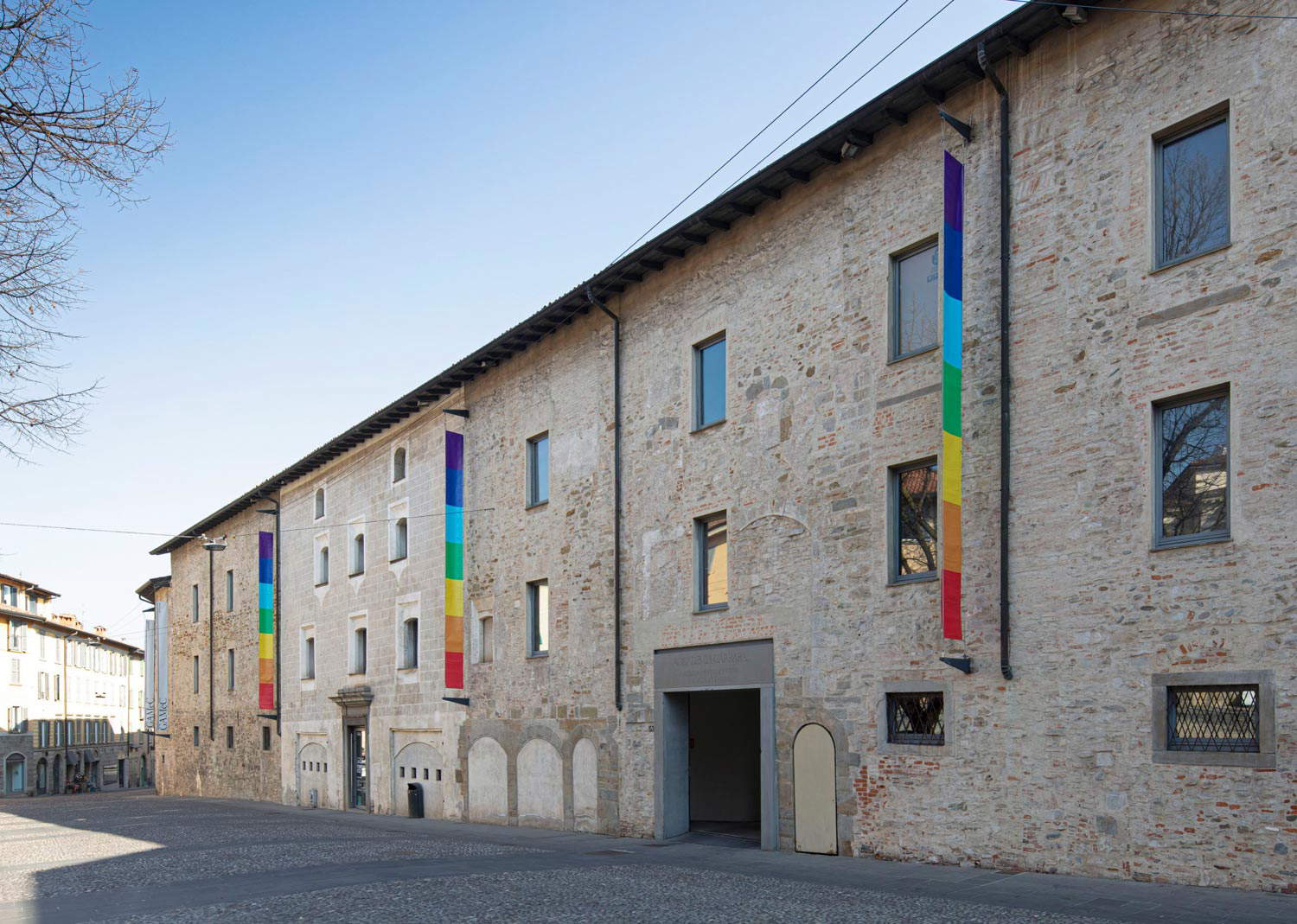
The Duomo is dedicated to St. Alexander, the city’s patron saint: the Bergamo cathedral, leaning against the Palazzo della Ragione with a neoclassical facade of white Botticino marble, is bursting with beauty and rich in decoration and works of art. The Piazza del Duomo in Bergamo Alta itself stands as one of the most important artistic sites in northern Italy. In here one can admire the altarpiece by Carlo Ceresa, as well as paintings by Tiepolo and works by Giovan Battista Moroni, Giovanni Cariani, Giambettino Cignaroli, and Sebastiano Ricci. Also of great importance is the wooden choir by Johann Karl Sanz with central stall by Andrea Fantoni. and the tiara of the “Good Pope,” John XIII of Bergamo, all in gold embellished with brilliants, pearls created by the hands of Attilio Nani. Each chapel is a small museum.
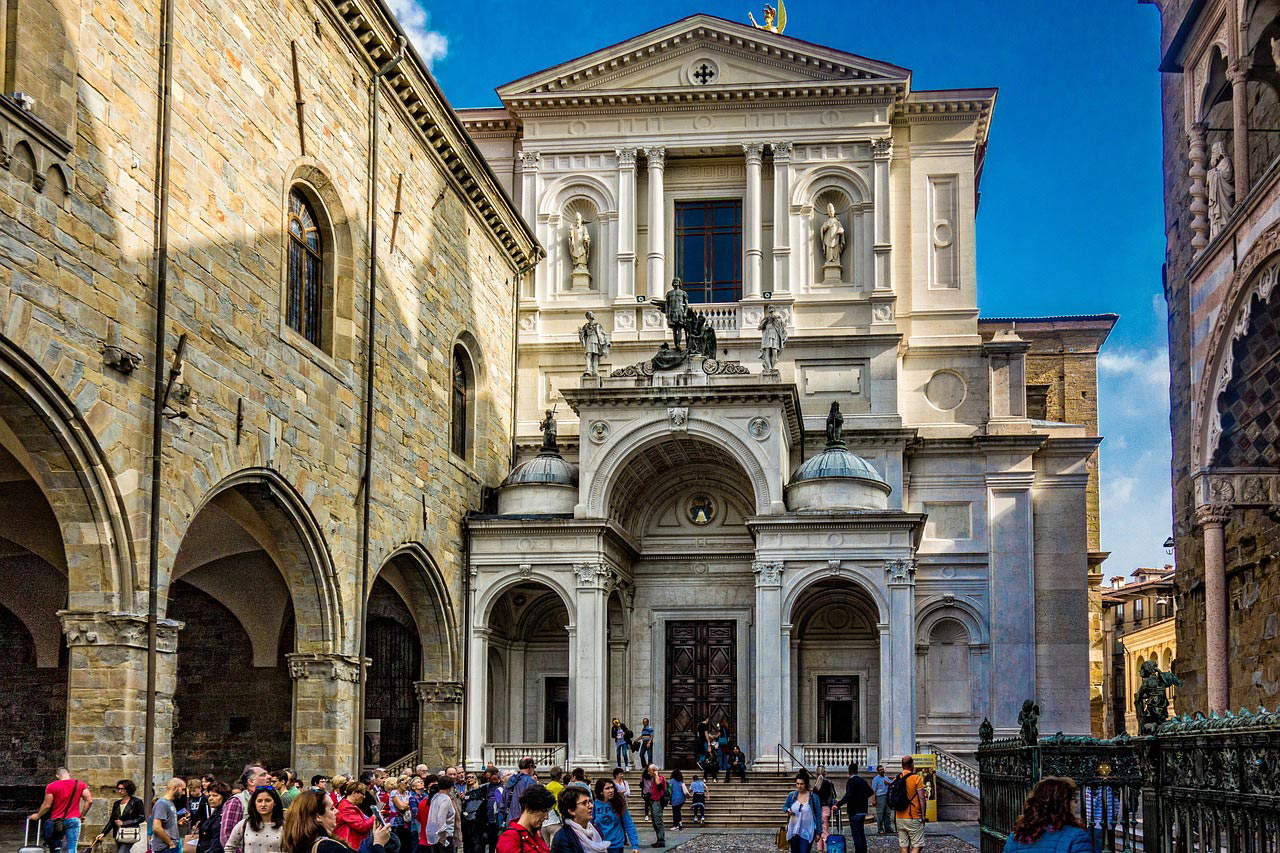
The Angelo Mai Library is one of Italy’s most important libraries and is housed in a prestigious building: the Palazzo Nuovo. Opened at the end of the 18th century, it has a very rich library collection in all fields and disciplines: as many as 730,000 volumes published from the 17th century to the present; 12,000 newspapers and magazines; over 9,000 manuscripts from the 11th to the 20th centuries, many of them illuminated; 125,000 photographs, 22,000 parchments and then correspondence, prints, drawings, cartographic maps and much more as well as the Historical Archives of the City of Bergamo from the 15th to the 20th century. All in a prestigious setting with the elegance of paintings and stuccoes, amid furniture and statues that within these monumental spaces accommodate this wealth of knowledge. In the Tassiana Hall there are also two ’globes’ of the times: the Globes of Vincenzo Maria Coronelli. With about 50 illustrated sheets on these 3-meter-diameter globes, they date back to the late 17th century.
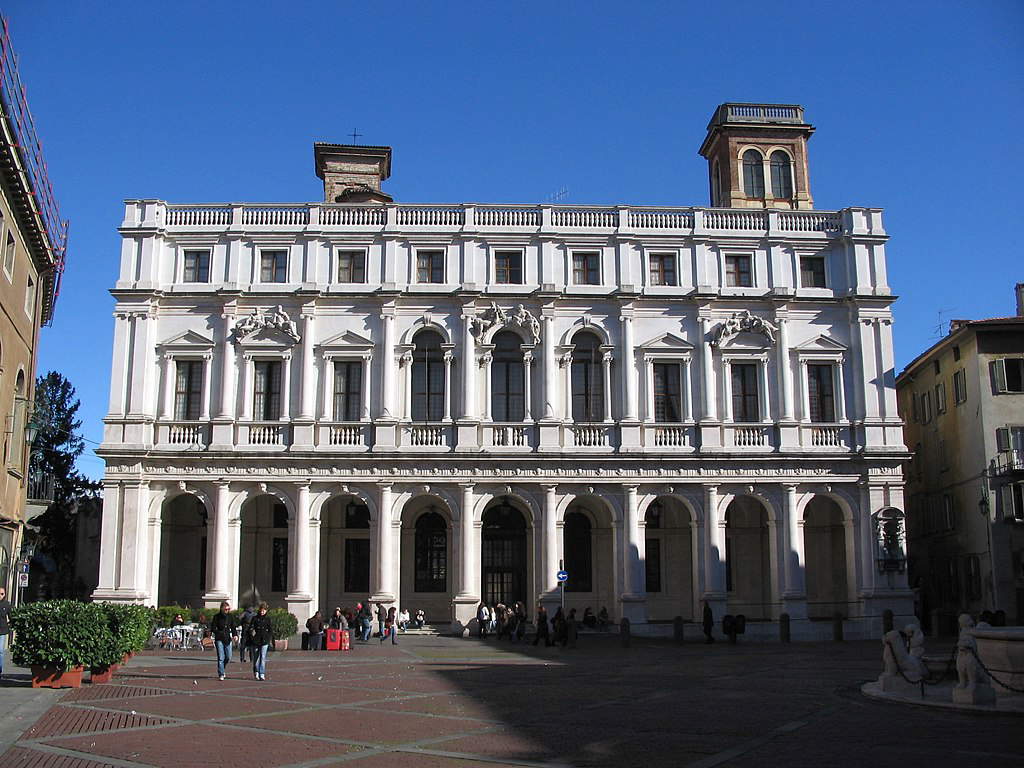
If the Upper City has ancient buildings and centuries-old beauties to go and visit, the Lower part of Bergamo is also no less remarkable for the urbanization that gave it a unique and extremely fascinating physiognomy during the 20th century thanks to the great architect Marcello Piacentini. It was he, in fact, who raised an entire district, the Piacentiniano Center, from the space formerly occupied by the 18th-century Fiera to make room for the political, administrative judicial and commercial activities that did not have the proper space in the Upper City. It was thus that a neighborhood was created by grafting itself into the existing and setting the example for all that came after. Bergamo underwent an urban transformation that from the early twentieth century continued until the 1980s, creating a model of elegance and sophistication for anyone walking through it, gazing at the Venetian Walls in the distance. The headquarters of the Local Bank and the Bank of Italy, Chamber of Commerce, the Public Prosecutor’s Office and the Palace of Justice, palaces with quadriporticos now a distinctive feature of the city that spread over Piazza Dante, Piazza Vittorio Veneto, the Sentierone and other streets. Palaces and architectures laden with history and decorations of great value.

The struscio dei bergamaschi is the Sentierone, which begins (or ends) at the Church of Saints Stephen and Bartholomew in the lower part of the City, encircling the living room of stores and offices with this airy tree-lined avenue in front of it. The facade is striking in perfect Baroque style by architect Giovanni Cuminetti. Decorating the facade are 4 female statues depicting the cardinal virtues, by Paleni and bas-relief depictions of the martyrdom of St. Bartholomew and that of St. Stephen. The interior contains Lorenzo Lotto’s large 1516 panel painting, the Martinengo Altarpiece, a masterpiece of the Venetian painter’s stay in Bergamo. It stands on an earlier church, and looking at the exterior one can codify the stratification of the eras of construction: the facade was redone in 1897, the outer portico on the left in 1942, and the side on Via Tasso is 19th-century.
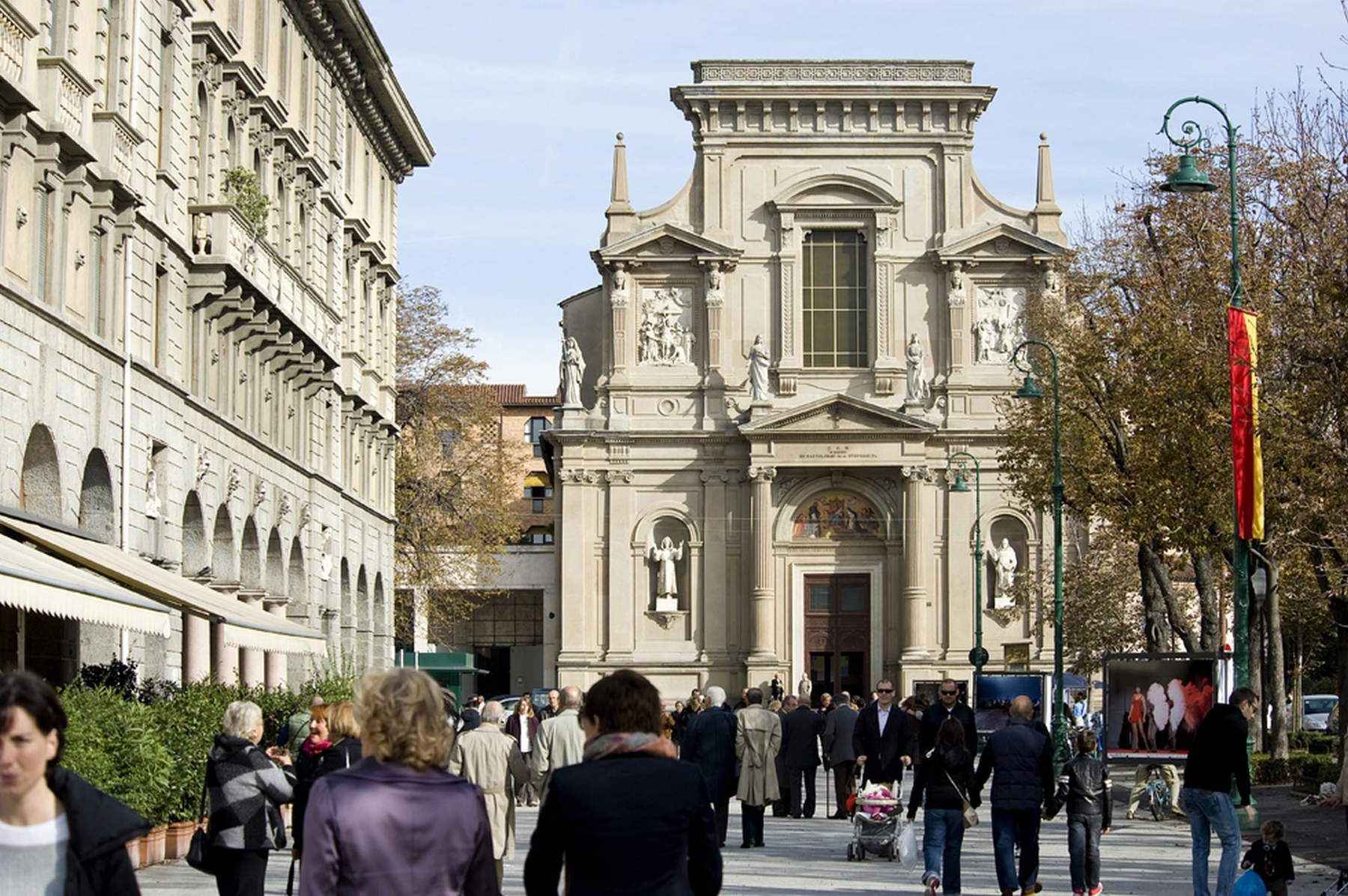
This is one of the most significant buildings of worship in Lower Bergamo, built on the site where, according to tradition, St. Alexander, the city’s patron saint, suffered martyrdom. The church has very ancient origins (an early building is thought to have been erected in early Christian times, although the first document attesting to the church’s presence dates from 1133). It was rebuilt in the 15th century although its present appearance is 18th-century, and the interior itself is in Baroque forms. The interior is filled with important works: in particular, there are paintings here by notable Bergamasque artists of the 16th and 17th centuries, such as Romanino, Gian Paolo Cavagna, Enea Salmeggia, Francesco Zucco, and Moretto. The sacristy also preserves an intense Lamentation over the Dead Christ by Lorenzo Lotto. A curiosity: the church is named after the “Crotacio column,” a Roman-era column visible in the churchyard, and which in turn is named after a personage who lived in Bergamo between the 2nd and 3rd centuries: the column’s Crotacio was the father of a Bergamascan, Lupo, who, according to tradition, erected the column in memory of his father on the very spot where, shortly thereafter, St. Alexander would be martyred, whose head was picked up, again according to popular tradition, by St. Grata, Lupo’s daughter and Crotacio’s niece. A place therefore of great importance for the city’s religiosity.
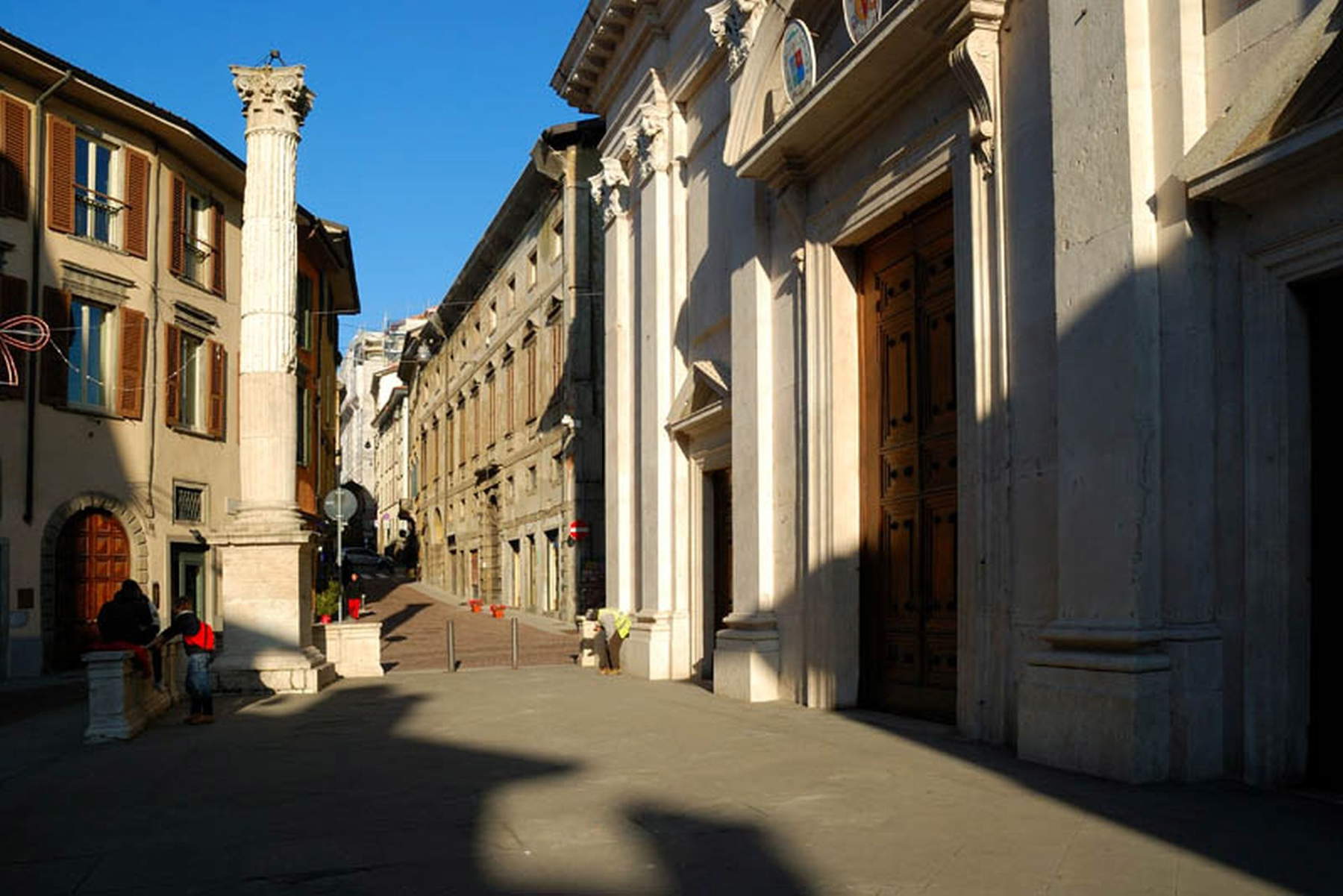
 |
| Bergamo, what to see: 10 places not to miss |
Warning: the translation into English of the original Italian article was created using automatic tools. We undertake to review all articles, but we do not guarantee the total absence of inaccuracies in the translation due to the program. You can find the original by clicking on the ITA button. If you find any mistake,please contact us.